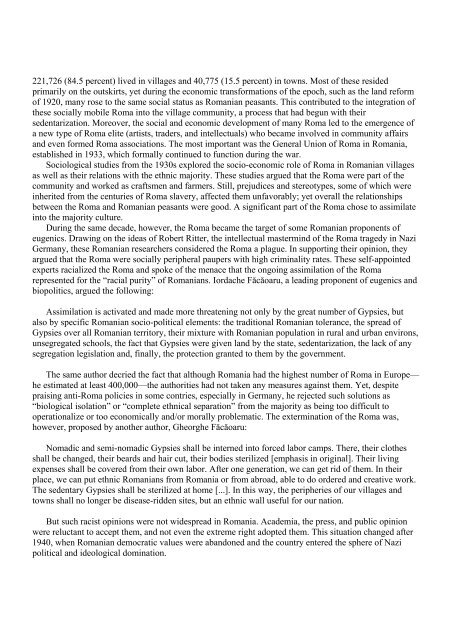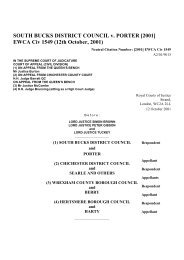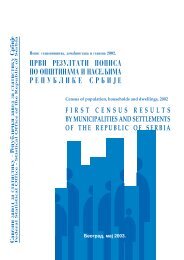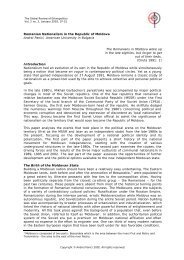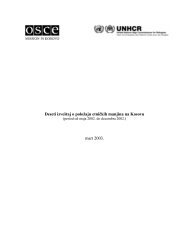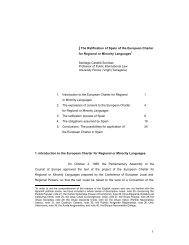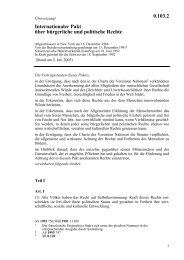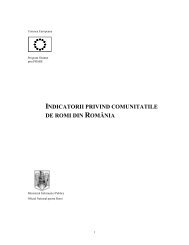Final Report of the International Commission on the - Minority Rights ...
Final Report of the International Commission on the - Minority Rights ...
Final Report of the International Commission on the - Minority Rights ...
Create successful ePaper yourself
Turn your PDF publications into a flip-book with our unique Google optimized e-Paper software.
221,726 (84.5 percent) lived in villages and 40,775 (15.5 percent) in towns. Most <str<strong>on</strong>g>of</str<strong>on</strong>g> <str<strong>on</strong>g>the</str<strong>on</strong>g>se resided<br />
primarily <strong>on</strong> <str<strong>on</strong>g>the</str<strong>on</strong>g> outskirts, yet during <str<strong>on</strong>g>the</str<strong>on</strong>g> ec<strong>on</strong>omic transformati<strong>on</strong>s <str<strong>on</strong>g>of</str<strong>on</strong>g> <str<strong>on</strong>g>the</str<strong>on</strong>g> epoch, such as <str<strong>on</strong>g>the</str<strong>on</strong>g> land reform<br />
<str<strong>on</strong>g>of</str<strong>on</strong>g> 1920, many rose to <str<strong>on</strong>g>the</str<strong>on</strong>g> same social status as Romanian peasants. This c<strong>on</strong>tributed to <str<strong>on</strong>g>the</str<strong>on</strong>g> integrati<strong>on</strong> <str<strong>on</strong>g>of</str<strong>on</strong>g><br />
<str<strong>on</strong>g>the</str<strong>on</strong>g>se socially mobile Roma into <str<strong>on</strong>g>the</str<strong>on</strong>g> village community, a process that had begun with <str<strong>on</strong>g>the</str<strong>on</strong>g>ir<br />
sedentarizati<strong>on</strong>. Moreover, <str<strong>on</strong>g>the</str<strong>on</strong>g> social and ec<strong>on</strong>omic development <str<strong>on</strong>g>of</str<strong>on</strong>g> many Roma led to <str<strong>on</strong>g>the</str<strong>on</strong>g> emergence <str<strong>on</strong>g>of</str<strong>on</strong>g><br />
a new type <str<strong>on</strong>g>of</str<strong>on</strong>g> Roma elite (artists, traders, and intellectuals) who became involved in community affairs<br />
and even formed Roma associati<strong>on</strong>s. The most important was <str<strong>on</strong>g>the</str<strong>on</strong>g> General Uni<strong>on</strong> <str<strong>on</strong>g>of</str<strong>on</strong>g> Roma in Romania,<br />
established in 1933, which formally c<strong>on</strong>tinued to functi<strong>on</strong> during <str<strong>on</strong>g>the</str<strong>on</strong>g> war.<br />
Sociological studies from <str<strong>on</strong>g>the</str<strong>on</strong>g> 1930s explored <str<strong>on</strong>g>the</str<strong>on</strong>g> socio-ec<strong>on</strong>omic role <str<strong>on</strong>g>of</str<strong>on</strong>g> Roma in Romanian villages<br />
as well as <str<strong>on</strong>g>the</str<strong>on</strong>g>ir relati<strong>on</strong>s with <str<strong>on</strong>g>the</str<strong>on</strong>g> ethnic majority. These studies argued that <str<strong>on</strong>g>the</str<strong>on</strong>g> Roma were part <str<strong>on</strong>g>of</str<strong>on</strong>g> <str<strong>on</strong>g>the</str<strong>on</strong>g><br />
community and worked as craftsmen and farmers. Still, prejudices and stereotypes, some <str<strong>on</strong>g>of</str<strong>on</strong>g> which were<br />
inherited from <str<strong>on</strong>g>the</str<strong>on</strong>g> centuries <str<strong>on</strong>g>of</str<strong>on</strong>g> Roma slavery, affected <str<strong>on</strong>g>the</str<strong>on</strong>g>m unfavorably; yet overall <str<strong>on</strong>g>the</str<strong>on</strong>g> relati<strong>on</strong>ships<br />
between <str<strong>on</strong>g>the</str<strong>on</strong>g> Roma and Romanian peasants were good. A significant part <str<strong>on</strong>g>of</str<strong>on</strong>g> <str<strong>on</strong>g>the</str<strong>on</strong>g> Roma chose to assimilate<br />
into <str<strong>on</strong>g>the</str<strong>on</strong>g> majority culture.<br />
During <str<strong>on</strong>g>the</str<strong>on</strong>g> same decade, however, <str<strong>on</strong>g>the</str<strong>on</strong>g> Roma became <str<strong>on</strong>g>the</str<strong>on</strong>g> target <str<strong>on</strong>g>of</str<strong>on</strong>g> some Romanian prop<strong>on</strong>ents <str<strong>on</strong>g>of</str<strong>on</strong>g><br />
eugenics. Drawing <strong>on</strong> <str<strong>on</strong>g>the</str<strong>on</strong>g> ideas <str<strong>on</strong>g>of</str<strong>on</strong>g> Robert Ritter, <str<strong>on</strong>g>the</str<strong>on</strong>g> intellectual mastermind <str<strong>on</strong>g>of</str<strong>on</strong>g> <str<strong>on</strong>g>the</str<strong>on</strong>g> Roma tragedy in Nazi<br />
Germany, <str<strong>on</strong>g>the</str<strong>on</strong>g>se Romanian researchers c<strong>on</strong>sidered <str<strong>on</strong>g>the</str<strong>on</strong>g> Roma a plague. In supporting <str<strong>on</strong>g>the</str<strong>on</strong>g>ir opini<strong>on</strong>, <str<strong>on</strong>g>the</str<strong>on</strong>g>y<br />
argued that <str<strong>on</strong>g>the</str<strong>on</strong>g> Roma were socially peripheral paupers with high criminality rates. These self-appointed<br />
experts racialized <str<strong>on</strong>g>the</str<strong>on</strong>g> Roma and spoke <str<strong>on</strong>g>of</str<strong>on</strong>g> <str<strong>on</strong>g>the</str<strong>on</strong>g> menace that <str<strong>on</strong>g>the</str<strong>on</strong>g> <strong>on</strong>going assimilati<strong>on</strong> <str<strong>on</strong>g>of</str<strong>on</strong>g> <str<strong>on</strong>g>the</str<strong>on</strong>g> Roma<br />
represented for <str<strong>on</strong>g>the</str<strong>on</strong>g> “racial purity” <str<strong>on</strong>g>of</str<strong>on</strong>g> Romanians. Iordache Făcăoaru, a leading prop<strong>on</strong>ent <str<strong>on</strong>g>of</str<strong>on</strong>g> eugenics and<br />
biopolitics, argued <str<strong>on</strong>g>the</str<strong>on</strong>g> following:<br />
Assimilati<strong>on</strong> is activated and made more threatening not <strong>on</strong>ly by <str<strong>on</strong>g>the</str<strong>on</strong>g> great number <str<strong>on</strong>g>of</str<strong>on</strong>g> Gypsies, but<br />
also by specific Romanian socio-political elements: <str<strong>on</strong>g>the</str<strong>on</strong>g> traditi<strong>on</strong>al Romanian tolerance, <str<strong>on</strong>g>the</str<strong>on</strong>g> spread <str<strong>on</strong>g>of</str<strong>on</strong>g><br />
Gypsies over all Romanian territory, <str<strong>on</strong>g>the</str<strong>on</strong>g>ir mixture with Romanian populati<strong>on</strong> in rural and urban envir<strong>on</strong>s,<br />
unsegregated schools, <str<strong>on</strong>g>the</str<strong>on</strong>g> fact that Gypsies were given land by <str<strong>on</strong>g>the</str<strong>on</strong>g> state, sedentarizati<strong>on</strong>, <str<strong>on</strong>g>the</str<strong>on</strong>g> lack <str<strong>on</strong>g>of</str<strong>on</strong>g> any<br />
segregati<strong>on</strong> legislati<strong>on</strong> and, finally, <str<strong>on</strong>g>the</str<strong>on</strong>g> protecti<strong>on</strong> granted to <str<strong>on</strong>g>the</str<strong>on</strong>g>m by <str<strong>on</strong>g>the</str<strong>on</strong>g> government.<br />
The same author decried <str<strong>on</strong>g>the</str<strong>on</strong>g> fact that although Romania had <str<strong>on</strong>g>the</str<strong>on</strong>g> highest number <str<strong>on</strong>g>of</str<strong>on</strong>g> Roma in Europe—<br />
he estimated at least 400,000—<str<strong>on</strong>g>the</str<strong>on</strong>g> authorities had not taken any measures against <str<strong>on</strong>g>the</str<strong>on</strong>g>m. Yet, despite<br />
praising anti-Roma policies in some c<strong>on</strong>tries, especially in Germany, he rejected such soluti<strong>on</strong>s as<br />
“biological isolati<strong>on</strong>” or “complete ethnical separati<strong>on</strong>” from <str<strong>on</strong>g>the</str<strong>on</strong>g> majority as being too difficult to<br />
operati<strong>on</strong>alize or too ec<strong>on</strong>omically and/or morally problematic. The exterminati<strong>on</strong> <str<strong>on</strong>g>of</str<strong>on</strong>g> <str<strong>on</strong>g>the</str<strong>on</strong>g> Roma was,<br />
however, proposed by ano<str<strong>on</strong>g>the</str<strong>on</strong>g>r author, Gheorghe Făcăoaru:<br />
Nomadic and semi-nomadic Gypsies shall be interned into forced labor camps. There, <str<strong>on</strong>g>the</str<strong>on</strong>g>ir clo<str<strong>on</strong>g>the</str<strong>on</strong>g>s<br />
shall be changed, <str<strong>on</strong>g>the</str<strong>on</strong>g>ir beards and hair cut, <str<strong>on</strong>g>the</str<strong>on</strong>g>ir bodies sterilized [emphasis in original]. Their living<br />
expenses shall be covered from <str<strong>on</strong>g>the</str<strong>on</strong>g>ir own labor. After <strong>on</strong>e generati<strong>on</strong>, we can get rid <str<strong>on</strong>g>of</str<strong>on</strong>g> <str<strong>on</strong>g>the</str<strong>on</strong>g>m. In <str<strong>on</strong>g>the</str<strong>on</strong>g>ir<br />
place, we can put ethnic Romanians from Romania or from abroad, able to do ordered and creative work.<br />
The sedentary Gypsies shall be sterilized at home [...]. In this way, <str<strong>on</strong>g>the</str<strong>on</strong>g> peripheries <str<strong>on</strong>g>of</str<strong>on</strong>g> our villages and<br />
towns shall no l<strong>on</strong>ger be disease-ridden sites, but an ethnic wall useful for our nati<strong>on</strong>.<br />
But such racist opini<strong>on</strong>s were not widespread in Romania. Academia, <str<strong>on</strong>g>the</str<strong>on</strong>g> press, and public opini<strong>on</strong><br />
were reluctant to accept <str<strong>on</strong>g>the</str<strong>on</strong>g>m, and not even <str<strong>on</strong>g>the</str<strong>on</strong>g> extreme right adopted <str<strong>on</strong>g>the</str<strong>on</strong>g>m. This situati<strong>on</strong> changed after<br />
1940, when Romanian democratic values were aband<strong>on</strong>ed and <str<strong>on</strong>g>the</str<strong>on</strong>g> country entered <str<strong>on</strong>g>the</str<strong>on</strong>g> sphere <str<strong>on</strong>g>of</str<strong>on</strong>g> Nazi<br />
political and ideological dominati<strong>on</strong>.


